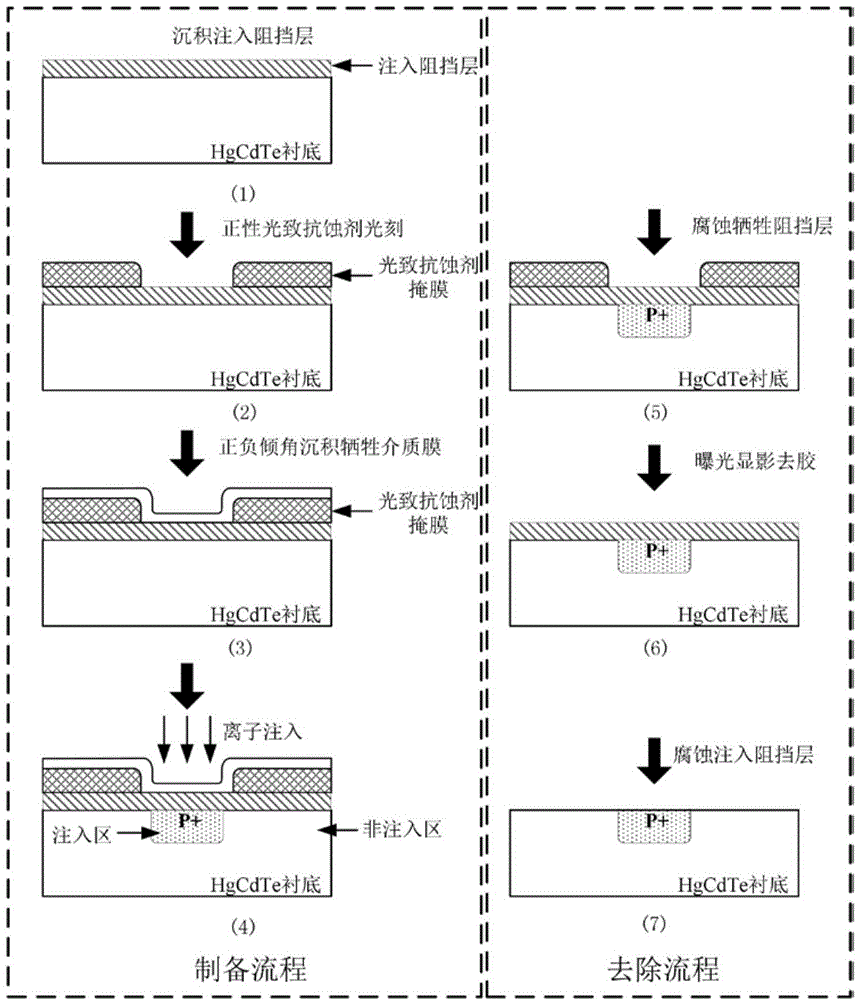Composite mask for high energy ion implantation
A composite mask and high-energy ion technology, which is applied in the field of masks, can solve the problems of easy residual photoresist mask, many process errors in graphic size, and affecting the blocking effect of thin film masks, so as to avoid device process failure, Avoiding mask residues and shortening the deglue time
- Summary
- Abstract
- Description
- Claims
- Application Information
AI Technical Summary
Problems solved by technology
Method used
Image
Examples
Embodiment 1
[0024] Using the mask preparation method described in the present invention, evaporation deposition, photolithography, and positive and negative inclination angle evaporation deposition are carried out on the surface of the mercury cadmium telluride epitaxial material chip. The preparation process is shown in the attached figure 2 shown. First, a cadmium telluride injection barrier layer (such as figure 2 As shown in (1), clean the chip, spin-coat a layer of positive photoresist with a thickness of 2 to 3 microns on the surface of the chip, use a photolithographic plate to expose the chip to ultraviolet light, and then develop and fix it. After that, obtain a photoresist implant mask (such as figure 2 (2) shown).
[0025] Load the chip with the mask pattern prepared on the sample stage of the high-vacuum thermal evaporation equipment, first rotate the sample stage at an inclination angle of 0°, and deposit ~20nm thick zinc sulfide film; then rotate the sample stage at an ...
Embodiment 2
[0029] Using the mask preparation method described in the present invention, evaporation deposition, photolithography, and positive and negative inclination angle sputter deposition are carried out on the surface of the mercury cadmium telluride epitaxial material chip. The preparation process is shown in the attached figure 2 shown. First, a cadmium telluride injection barrier layer (such as figure 2 As shown in (1), clean the chip, spin-coat a layer of positive photoresist with a thickness of 2 to 3 microns on the surface of the chip, use a photolithographic plate to expose the chip to ultraviolet light, and then develop and fix it. After that, obtain a photoresist implant mask (such as figure 2 (2) shown).
[0030] Load the chip with the prepared mask pattern on the sample stage of the magnetron sputtering equipment, first rotate the sample stage at an inclination angle of 0°, and sputter a silicon dioxide film with a thickness of ~10nm; then rotate the sample stage at a...
Embodiment 3
[0034] Using the mask preparation method described in the present invention, evaporation deposition, photolithography, and positive and negative inclination angle evaporation deposition are carried out on the surface of the mercury cadmium telluride epitaxial material chip. The preparation process is shown in the attached figure 2 shown. First, a cadmium telluride injection barrier layer (such as figure 2 As shown in (1), clean the chip, spin-coat a layer of positive photoresist with a thickness of 2 to 3 microns on the surface of the chip, use a photolithographic plate to expose the chip to ultraviolet light, and then develop and fix it. After that, obtain a photoresist implant mask (such as figure 2 (2) shown).
[0035] Load the chip with the prepared mask pattern on the sample stage of the high-vacuum thermal evaporation equipment, first rotate the sample stage at an inclination angle of 0°, and deposit ~80nm thick zinc sulfide film; then rotate the sample stage at an ...
PUM
 Login to View More
Login to View More Abstract
Description
Claims
Application Information
 Login to View More
Login to View More - R&D
- Intellectual Property
- Life Sciences
- Materials
- Tech Scout
- Unparalleled Data Quality
- Higher Quality Content
- 60% Fewer Hallucinations
Browse by: Latest US Patents, China's latest patents, Technical Efficacy Thesaurus, Application Domain, Technology Topic, Popular Technical Reports.
© 2025 PatSnap. All rights reserved.Legal|Privacy policy|Modern Slavery Act Transparency Statement|Sitemap|About US| Contact US: help@patsnap.com


